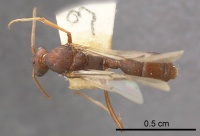Rhytidoponera levior
| Rhytidoponera levior | |
|---|---|

| |
| Scientific classification | |
| Kingdom: | Animalia |
| Phylum: | Arthropoda |
| Class: | Insecta |
| Order: | Hymenoptera |
| Family: | Formicidae |
| Subfamily: | Ectatomminae |
| Tribe: | Ectatommini |
| Genus: | Rhytidoponera |
| Species: | R. levior |
| Binomial name | |
| Rhytidoponera levior Crawley, 1925 | |
| Synonyms | |
| |
Wheeler (1934): Numerous workers from a few large crater nests near the Tourist Camp Reserve (Rottnest Island) at the eastern end of the island (Wheeler, X. 22, '31) and at the extreme western and near Cape Vlaming (Darlington, X. 23, '31).
Identification
Heterick (2009) - Morphologically very similar to Rhytidoponera punctata.
Keys including this Species
Distribution
Heterick (2009) - A predominantly coastal distribution in the Perth metropolitan area but was described from Rottnest Island.
Distribution based on Regional Taxon Lists
Australasian Region: Australia (type locality).
Distribution based on AntMaps
Distribution based on AntWeb specimens
Check data from AntWeb
Countries Occupied
| Number of countries occupied by this species based on AntWiki Regional Taxon Lists. In general, fewer countries occupied indicates a narrower range, while more countries indicates a more widespread species. |

|
Estimated Abundance
| Relative abundance based on number of AntMaps records per species (this species within the purple bar). Fewer records (to the left) indicates a less abundant/encountered species while more records (to the right) indicates more abundant/encountered species. |

|
Biology
Castes
Nomenclature
The following information is derived from Barry Bolton's Online Catalogue of the Ants of the World.
- levior. Rhytidoponera punctata var. levior Crawley, 1925b: 581 (w.) AUSTRALIA (Western Australia: Rottnest I.).
- Type-material: holotype (?) worker.
- [Note: no indication of number of specimens is given.]
- Type-locality: Australia: Western Australia, Rottnest I., no. 250 (Mathews).
- Type-depository: OXUM.
- Clark, 1936: 61 (m.).
- Subspecies of punctata: Wheeler, W.M. 1934d: 139.
- Status as species: Clark, 1936: 61 (redescription); Taylor, 1986: 35; Taylor, 1987a: 69; Bolton, 1995b: 379; Heterick, 2009: 139.
- Senior synonym of douglasi: Taylor, 1986: 35; Taylor, 1987a: 69; Bolton, 1995b: 379.
- Distribution: Australia.
- douglasi. Rhytidoponera douglasi Brown, 1952f: 137.
- Unnecessary replacement name for Rhytidoponera mayri r. glabrius var. laevior Stitz, 1911a: 352; unavailable (infrasubspecific) name.
- Status as species: Brown, 1958g: 203, 271; Taylor & Brown, 1985: 42.
- Junior synonym of levior: Taylor, 1986: 35; Taylor, 1987a: 69; Bolton, 1995b: 379.
Type Material
- Rhytidoponera punctata levior Crawley, 1925: Syntype, 1 worker, Rottnest Island, Western Australia, Australia, Australian National Insect Collection.
- Rhytidoponera punctata levior Crawley, 1925: Syntype, 2 workers, Rottnest Island, Western Australia, Australia, Museum of Comparative Zoology.
- Rhytidoponera punctata levior Crawley, 1925: Syntype, 1 worker, Rottnest Island, Western Australia, Australia, Oxford University Museum of Natural History.
- Rhytidoponera punctata levior Crawley, 1925: Syntype, 1 worker, from type series but may not be a type, Rottnest Island, Western Australia, Australia, Western Australian Museum.
Unless otherwise noted the text for the remainder of this section is reported from the publication that includes the original description.
Description
Worker
Somewhat darker than typical punctata. The eyes are not quite so close to the occiput, the occipital angles more rounded, and there is no sign of a carina, though the border is slightly depressed in the middle. (In punctata there is a feeble occipital carina.) The scape passes the occipital border by exactly one-third (in punctata by rather more). Otherwise similar in form.
Whole body, as in the type, densely and finely reticulate, except the back of the occiput, which is smoother and more shining than in the type. The head in addition has small punctures, much smaller, rounder, more shining, and further apart than in punctata.
On the thorax the punctures are even smaller and less abundant than on the head, and on the petiole the sculpture is less coarse than in the type. The superficial punctures on the gaster are also smaller and less abundant.
References
- Clark, J. 1936. A revision of Australian species of Rhytidoponera Mayr (Formicidae). Mem. Natl. Mus. Vic. 9: 14-89 (page 61, male described, raised to species)
- Crawley, W. C. 1925b. New ants from Australia. - II. Ann. Mag. Nat. Hist. 9(16): 577-598. (page 581, worker described)
- Heterick, B. E. 2009. A guide to the ants of South-western Australia. Records of the Western Australian Museum, Supplement 76:1-206.
- Heterick, B.E. 2021. A guide to the ants of Western Australia. Part I: Systematics. Records of the Western Australian Museum, Supplement 86, 1-245 (doi:10.18195/issn.0313-122x.86.2021.001-245).
- Heterick, B.E. 2022. A guide to the ants of Western Australia. Part II: Distribution and biology. Records of the Western Australian Museum, supplement 86: 247-510 (doi:10.18195/issn.0313-122x.86.2022.247-510).
- Taylor, R. W. 1986. The quadrinominal infrasubspecific names of Australian ants (Hymenoptera: Formicidae). Gen. Appl. Entomol. 18: 33-37 (page 35, Senior synonym of douglasi)
- Wheeler, W. M. 1934d. Contributions to the fauna of Rottnest Island, Western Australia. No. IX. The ants. J. R. Soc. West. Aust. 20: 137-163.
